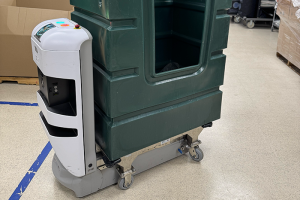Diagnosing health facility pest activity

Knowledge of pest activity can inform preventive measures or calls for professional treatment.
Pest prevention and control is a complex process that often is outsourced in health care facilities.
However, environmental services (ES) professionals still need to understand when pests are active, how to determine whether they're present, steps to take to prevent pest activity and treatments that a pest management provider may recommend to remediate any problems.
This knowledge can inform preventive measures as part of an integrated pest management (IPM) program, which includes nonchemical solutions, as well as provide an alert to call in experts for professional treatment.
Variety of pests
Flies, ants and cockroaches are the most common pests found in health care facilities, according to a 2013 survey of Association for the Healthcare Environment (AHE) members, and all pests pose unique threats.
Also in this article |
| Pest prevention tips for health care facilities |
|
|
Cockroaches can pick up and transfer harmful bacteria. In certain situations, ants can as well. Flies can spread microorganisms, some of which can cause diseases, when they land. Rats and mice also can cause serious health problems. Bed bug bites can cause minor to complex skin reactions and, in some cases, psychological concerns.
Not only can many pests spread dangerous bacteria that can cause diseases, but patients with weakened immune systems in health care facilities face a greater risk of infection.
Knowing about the pests and how to discover them is the first step in preventing infestation. A look at each of the main threats and their characteristics includes:
Ants. These insects are resilient pests because their diet habits change over time; their colonies can have massive populations; they can travel long distances to find food; and they go to great lengths to protect their colonies.
You may also like |
| Controlling pests in health care facilities |
| Facility-specific health care pest management |
| Watching for pest hot spots |
|
|
Inside, ants often are found nesting in walls or beneath the floor. Their colonies can contain one or more queens with more than 100,000 workers, depending on the species. They are most active in spring, summer and fall.
Recommended prevention tips for ants are exclusion and clearing overgrown landscaping; and potential treatments include pheromones, baits and other residual pesticides.
Bed bugs. These parasitic insects feed on human and animal blood to survive. They reproduce and spread quickly, but they aren’t known to transmit human diseases.
Common signs of bed bugs include live or dead bed bugs, skins cast off during the molting process, small spots of reddish-black fecal material and tiny cream-colored eggs, usually found in dark crevices. They are active throughout the year.
Bed bugs cannot be completely prevented so early detection is critical. Tactics include ongoing inspections; and treatments include residual pesticides and heat treatments.
Birds. Pigeons, starlings and house sparrows are the three main pest birds. They can carry more than 60 diseases, and their feathers and droppings also can lead to health threats.
Hot spots for birds include roofs, ledges and outdoor patios. They often gather to socialize with each other, consume food and water, sleep, or breed and create nests. While seasonality differs depending on the type of bird, pigeons may be seen year-round and house sparrows can be found wherever there are people.
Tips for prevention include exclusion and sanitation; and potential treatments are sterilants, netting, spikes and repellents.
Cockroaches. These insects are a major health concern, as they can spread disease, contaminate food, trigger allergies and even cause asthma.
Cockroaches can enter buildings through cracks, crevices, vents, sewers and drain pipes. Sometimes patients unknowingly bring them in on personal belongings. These pests reproduce rapidly, are difficult to control and are active throughout the year.
Prevention tips include exclusion and sanitation; and potential treatments are insect growth regulators, baits and other residual pesticides.
Crickets. These insects usually do not pose a health or structural damage threat, but they are a nuisance. Sometimes their chirping is loud enough to interrupt sleep.
Crickets often are found around mulch and under dead plants. They thrive in areas that offer humidity, moisture and plant cover. Crickets are most active in spring, summer and fall.
Prevention measures for crickets include exclusion and clearing overgrown landscaping; and potential treatments are baits and other residual pesticides.
Fleas. Adult fleas draw blood from host animals like dogs, cats, rabbits, rodents and other domesticated or wild animals and occasionally humans. They can transmit diseases like tapeworm and flea-borne typhus.
These parasitic insects can cause itchy bite marks in humans and cause animals to scratch themselves repeatedly. Flea dirt, or adult flea feces, can indicate activity as well. Flea dirt looks similar to ground black pepper and may be seen in carpets and rugs. Fleas are most active in spring and summer.
Prevention tips for fleas include ongoing inspections and sanitation; and potential treatments include residual pesticides, insect growth regulators and pet treatments.
Flies. House, phorid, cluster, blow and fruit flies are all pests that can affect health care facilities. House flies are associated with more than 100 pathogens, and they carry twice as many pathogens as cockroaches.
Flies tend to congregate near uncovered food, decaying matter and spilled liquids. They reproduce rapidly, so a population explosion can occur when the issue is not managed properly. While most common flies are active in spring and summer, species like cluster flies are also quite active in winter and fall.
Some prevention measures are exclusion and sanitation, while treatments include insect light traps, baits and other residual pesticides.
Ladybugs. Ladybugs occur in a wide spectrum of colors, ranging from yellow to orange to red, and have a varying number of spots. Because of the wide range of colors, people sometimes don’t know that they are all the same species. Most ladybugs prey on aphids, mealybugs and scale insects.
Ladybugs can gather in large numbers on light-colored buildings, where they find holes to enter health care facilities. They hibernate through the winter and become active in late winter and spring. In the fall, they are commonly seen on building exteriors.
Exclusion is the top prevention tip for ladybugs; and insect light traps and residual pesticides are treatment tactics.
Rodents. Rodents are known carriers of deadly diseases. They don’t need a large opening to get inside: Rats can squeeze through an opening as small as a quarter, while a mouse can fit into a hole smaller than a dime. They often enter structures in cooler times to escape winter temperatures.
Rodent infestations can prove to be extremely destructive. Signs may include droppings, rub marks or burrows. They tend to gather where food and water are readily available, such as in employee breakrooms or food-service areas. They are active throughout the year.
Prevention measures for rodents encompass exclusion, sanitation and clearing overgrown landscaping; while potential treatments include glueboards, baits, traps and sterilants.
Spiders. If an environmental services professional sees spiders in his or her health care facilities, it could signal a larger pest problem. Spiders live near their food sources, which are actually insects.
Depending on the type of spider found at a health care facility, evidence of their activity may vary. Spiders hide in numerous places and catch prey in three different ways: by their webs, hunting them and trapping them. While spiders remain active during the winter, they are more active during spring, summer and fall.
Exclusion and sanitation are among the prevention measures for spiders; and glueboard and residual pesticides are potential treatments.
Termites. Termites are called “silent destroyers” because they can be difficult to detect and often cause structural damage before being discovered. These pests cause more than $5 billion in damage annually in the United States.
Warning signs of termite infestations may include temporary swarms of winged termites during the spring, discarded wings, cracked or bubbling paint, mud tubes on walls of the building and wood that sounds hollow when tapped. Termites are active throughout the year.
Prevention tips include ongoing inspections and landscaping that keeps moisture away from structures; and treatments include baits and other residual pesticides.
Signs of activity
ES professionals should work with their providers to train staff on the signs of pest activity and the roles they can play in keeping pests away through an IPM program.
Additionally, ES professionals should create a logbook to document pest sightings and treatments.
Each case is different, so it’s recommended to consult with a pest management professional about the treatments that are most appropriate for each situation and facility.
The more proactive ES professionals are with their pest management providers, the more effective will be the prevention program.
Ron Harrison, Ph.D., is an entomologist and director of technical services for Orkin LLC. He can be contacted at rharriso@orkin.com.



